MINNEOPA FALLS
Blue Earth County, Minnesota.
PAGE CURRENTLY UNDER CONSTRUCTION. THANK YOU FOR YOUR PATIENCE.
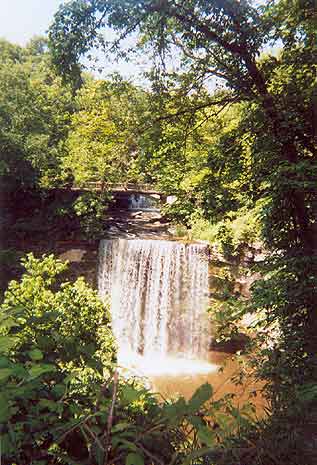 Lower Falls, Minneopa Park. Minneopa Falls Painting (1862) |
|
||||
|
Further Developments One factor that helped enhance the development of Minneopa State Park was the coming of the railroad. In the late 1860's the St. Paul & Sioux City Railroad was working its way through the Southern Minnesota countryside from St Paul and constructed depots in Le Sueur, St Peter and Mankato. On November 6, 1869 the trestle work across Minneopa Creek was completed, the track was laid in two days and the railroad enventually continued on to Lake Crystal. The owner of Minneopa Falls at that time was D. C. Evans was and when the railroad company decided to locate a depot near the falls, he created a townsite called "Minneopa." A few years earlier, in 1867, D. C. Evans had plans to sell the property to "a party from out east" but he was still in possession when, in August of 1869, he took out a newspaper ad asking for investors. See Ad |
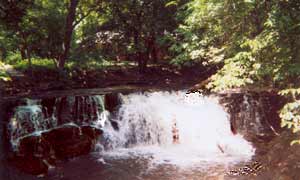
Upper Falls, Minneopa Park |
|
A story in the Mankato Record of February 26, 1870 stated that the St Paul & Sioux City Railroad was putting up a grain and freight warehouse at the "Minneinneopa Station." A hotel, blacksmith shop and lumber yard soon followed. D. C. Evans cleared the area of brush and removed fallen trees from near the falls. He also constructed wooden steps going into the ravine and built bridges over the creek. The town of Minneopa flourished and the Falls became a popular spot for picnics and church gatherings. But, alas, this prosperity was short lived. In 1873 a grasshopper plague, which lasted for three years, descended on Minnesota causing extensive destruction on farms. With three successive years of crop failure the town was unable to continue and was abandoned. Minneopa State Park Although the town of Minneopa ceased to exist the falls was still a popular tourist attraction for visitors to gather, have picnics and enjoy the natural beauty of the area. In 1905, Blue Earth County state legislator, Ezra Gates introduced a bill that would designate the land which encompasses Minneopa Falls into a public State Park. The bill met with great success and on April 19, 1905 the bill was passed making Minneopa State Park the third state park in Minnesota. The arch concrete foot bridge was constructed in 1921. This foot bridge has endured much use over the years as a convenient path over the creek and as place to relax and watch the water below cascade over the lower falls. Because the upper falls was in the process of disintigrating through erosion the Lundin Brothers of Mankato in 1928 built a wall of durable rock and cement under the hard limestone ledge. This allowed it to maintain its beauty as a waterfall rather than to erode into a series of rapids. (more information is needed here.) |
|
|
|||||
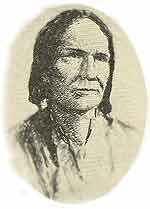 Sintomniduta ("Red All Over") |
Story of Sintomniduta At the bottom of the rock wall to the left of Minneopa Falls is a large depression that was once the Cave of Sintomniduta. It was named after Sintomniduta, chief of a Sisseton tribe who had their village on the banks of Minneopa Creek and roamed predominantly on the lands at the bend of the Minnesota River. The name Sintomniduta (sometimes spelled "Sidominadota") translates from the Dakota language as "Red All Over," He was also known as Napenomnana which in English means "Two Fingers." He had lost three fingers when a gun was accidentally discharged. Sintomniduta had penetrating black eyes, high cheek bones and stood five feet ten inches tall. It was also said he had double rows of teeth in both jaws. In the fall of 1853 Sintomniduta's sister who was married to another chief, named Frenchman, came to her brother for protection. Her husband had accused her of infidelity, an offense for which the punishment under Dakota law is to have the tip of one's nose cut off. Sintomniduta took her to the falls of Minneopa where she hid in a cave under the falls. Later, he and members of his tribe attacked Frenchman's village, in a skirmish that wounded the Frenchman and left one of his men dead. Frenchman escaped to the recently settled area at Mankato where, for most of the winter, his wounds were treated by Dr. Adams and Dr. Heath. |
|
Death of Sintomniduta The events that led up to the death of Sintomniduta began as far back as 1848. In that year he traced some stolen horses to Henry Lott a horse-stealing bootlegger who had a cabin near Boone, Iowa. The Wapekutahs, led by Sintomniduta, destroyed the inside of Lott's cabin and mistreated Mrs Lott and the rest of the family. Although she survived, she later died as a result of the cruel treatment received. Meanwhile, Henry Lott and his stepson escaped but lot vowed revenge on the Wapekutahs. In January of 1854 Sintomniduta and his family were on a hunting expedition on the east branch of the Des Moinew River and had camped about twenty-five miles north of Fort Dodge close to where Henry Lott had constructed a new cabin. Lott and his stepson lured Sintomniduta away from his camp with the story that a large herd of elk was in the area and suggested he join them for the hunt. When away from the campsite the Lotts killed Sintomniduta. Later that night they dressed as Indians and and returned to the camp to murder the rest of the family. The only survivors were Sintomniduta's daughter and his son, Joshpaduta. The crime was reported and a party of whites and Indians was dispached to find Lott but nothing was accomplished. Henry Lott and his stepson sold all there property and escaped to California. Allegedly, Lott was killed in that state during a fight. |
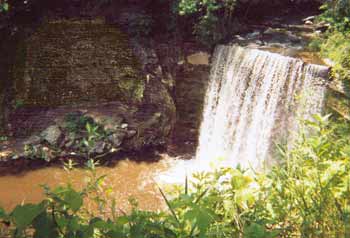 The Cave of Sintomniduta |
||
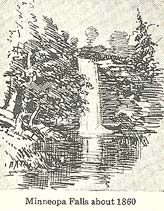 |
Formation of Minneopa Falls The forces that created Minneopa Falls began during the last ice age 15,000 years ago. As the final glacier retreated it left behind Lake Agassiz, which covered most of the northern part of Minnesota. Lake Agassiz was drained by the Glacial River Warren whose waters carved what is now the Minnesota River Valley. As Lake Agassiz receded to create the lakes of Northern Minnesota, Glacial River Warren was consequently reduced in size and the water now flows as the Minnesota River. About 14,000 years ago when Minneopa Falls first appeared it was located at the confluence of Minneopa Creek and the Minnesota River and gradually its position was moved farther up the creek. The Minneopa Creek bed consists of Jordan sandstone that erodes at different rates and the process of "downcutting" eventually eroded the less resistant layers to create the present day Minneopa Falls. |
|
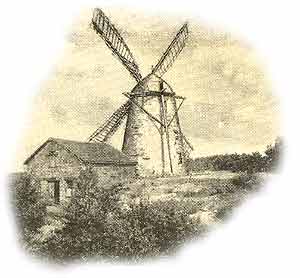 |
Construction of Seppmann Mill An interesting feature of Minneopa State Park is the Seppmann Mill. Construction of the mill began in the summer of 1862 by Louis Seppmann who was a stone mason by trade and had just completed the building of a mill in Mankato. When the walls were about ten feet high the project had to be halted due to lack of funds and the Dakota Rebellion in August. The following summer a neighbor, Herman Hegley joined to assist in the construction. When the mill was completed in 1864 it was 32 feet high and the spread of the arms was 72 feet. A tracking system made it possible to reposition the blades to take advantage of any wind direction. People from 20 to 30 miles away would bring their produce to the mill which, when the wind was favorable, could process 150 bushels of wheat a day. |
|
End of Operations For several years Seppmann's Mill enjoyed great success. But during a lightning storm in June of 1873 two of the blades were destroyed. They were replaced and the mill resumed operations. However, in the summer of 1880 a tornado tore off two of the blades again. By this time the technology of milling had advanced enough to make the windmill obsolete and the damage was not repaired. For the next ten years Louis Seppmann, with the remaining two arms continued running the mill as a feed mill. Then, in 1890, another storm took away the last two blades and the mill was never used again. Part of the State Park System In 1930 heirs of Louis Seppmann gave the mill and the land around it to the Blue Earth County Historical Society. The society made a number of structural repairs and, in 1931, donated it to Minneopa State Park. Attempts were made in the 1970's to reconstruct the mill to its original condition but they were eventually abandoned. |
|
Here will be information about the prairie area that the Dakota called Tinta Inya Ota ("prairie with many rocks"). along with pics of the mill and glacial erratics that are spread over the field. Also talk about the view seen from two scenic overlooks of the Minneopa Creek ravine at Williams nature center. Awaiting photos and information. |
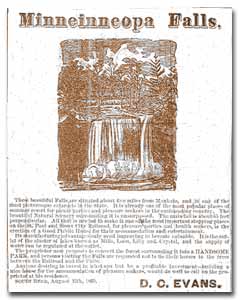
This newspaper ad appeared in |
These beautiful Falls are situated about five miles from Mankato, and is one of the D. C. EVANS. |
|